By Li Meng-hsueh
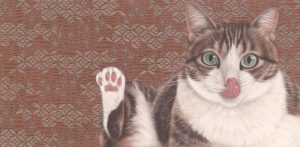
A series of gouaches by Taiwanese artist Chen Pei-yi, featuring cats as the main subject, was exhibited at the Japanese gallery GALLERY SCENA. by SHUKADO in ART TAIPEI 2022. This image features Chen Pei-yi's recent work "At the Foot of the Mountain" exhibited at her solo exhibition in GALLERY SCENA. by SHUKADO titled "I shall be unique in all the world." Image/© Chen Pei-yi.
While appreciating the works during ART TAIPEI, we often come across some refined and radiant artworks. Upon closer inspection, we often find that the labels of those artworks read "mineral pigments," and the galleries introduce them as "gouache." What exactly does the term 'gouache' refer to? In the relevant research literature on senior painters, we see their works referred to as gouaches. Further, it is found that they have some similarities to fine brushwork with heavy-color paintings. However, contemporary artists' gouache works seem indistinguishable from Western-style paintings, which can be confusing.
To delve into the subject of gouache, we may need to start with its origins.
Nihonga, Toyoga, Gouache
Gouaches in Taiwan can be traced back to the Japanese ruling period, when it was introduced from Japan and adapted from the traditional Nihonga (Japanese painting) of the Maruyama-Shijo School. It made its official debut at the Taiwan Fine Art Exhibition (also known as Taiten) in 1927. At that time, Taiten classified artworks into Seiyoga (Western-style Painting) and Toyoga (Eastern-style Painting) Painting. Toyoga was used to encompass traditional painting forms in Taiwan, Korea, and other places.
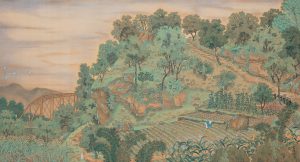
Kuo Hsueh-hu, “Scenery Near Yuan Shan”, 1928, Gouache on silk, 94.5×188 cm Collection of Taipei Fine Art Museum
However, with the hosting of Taiten, the "Toyoga Division" became an important channel for Taiwanese to understand or learn Nihonga. Take Kuo Hsueh-hu as an example. Although his traditional ink landscape "Stream through Pine Ravine" was selected for the inaugural Taiten, he quickly shifted his painting style. By adopting a plein air approach and using brushstroke-outline with luxury color techniques, he created "Scenery Near Yuan Shan," which was selected for the second Taiten, to some extent establishing a local Taiwanese style of Nihonga. Subsequently, the "Eastern-style Painting Division" of the Taiten essentially became dominated by Nihonga, playing a pivotal role in how Taiwanese perceived or engaged in Nihonga.
In 1946, after the end of World War II, the "Provincial Fine Art Exhibition" was held with the efforts of Yang San-lang and Kuo Hsueh-hu. The exhibition accepted submissions in three categories: "Western-style painting," "National painting," and "Sculpture." It is worth noting that the former "Eastern-style painting" was directly renamed as "National painting (Chinese painting)" in this exhibition, but in fact, most of the submitted works were still in the Nihonga style. This led to a controversy in the 1950s about whether the works in the Chinese painting division were "Nihonga" or "Chinese painting." This controversy is known as the "Orthodox National Painting Dispute." In the late 1970s, gouache such as Lin Chih-chu proposed to use the name "gouache" to avoid ideological standpoints. Since then, "gouache" has been accepted and has become a common name in the art circle.
Entering Schools and the Market
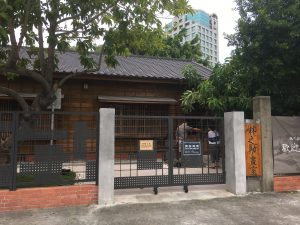
Lin Chih-chu's former residence in Taichung, located near the Liuchuan Canal, was where he taught gouache classes in the past.
The residence has since been converted into the Lin Chih-chu Memorial Hall. Photo/© Tsai Cheng-yun.
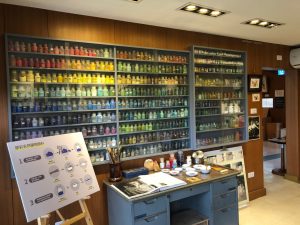
The artist's wall of paints and the adjacent gouache information board by the museum demonstrate the high cost of gouache, which is one of the reasons why gouache is still a niche medium for artists. Photo/© Elanor Wang
Although many painters have been creating gouaches since the Japanese ruling period, the postwar art education system has been slow to offer gouache courses. The post-war generation of gouache painters has been relying on private tutoring to pass on their skills. For example, Lin Chih-chu's students, Huang Den-tang and Tseng Teh-biao, studied painting at Lin's home during their spare time. Moreover, in the early post-war period, Taiwan's art market was not well-developed. Artists who relied on selling their paintings struggled to find local buyers. In addition, the government at the time claimed to be the orthodox Chinese government, and favored the promotion of ink painting. As a result, gouaches were mostly sold to Japan. This was partly because many painters had personal connections in Japan, and partly because gouaches originated in Japan and making it naturally more appealing to Japanese buyers.
It was not until 1985 that Chiang Hsun, then the chair of the Department of Fine Arts at Tunghai University, invited Lin Chih-chu, who had moved to the United States, to return to Taiwan to teach gouache. This was the first time that a Taiwanese university had offered a gouache course. As a result, Taiwanese gouache saw a new development, and Tunghai University became a leading institution in the teaching of gouache in Taiwan. As the number of students studying gouache increased, more and more people chose to study in Japan, the birthplace of gouache. Once a declining art form, gouache now has a relatively stable population of creators.
Meanwhile, the rapid development of commercial galleries in Taiwan in the 1980s, coupled with the "rediscovery" of Taiwanese senior painters by Taiwanese art historians, made them the popular icons of the emerging art market in the context of Taiwan's booming economy. However, galleries often emphasized senior painters' historical value and positioning rather than specific painting genres. In recent years, the works of senior painters have been on the rise due to the renewed attention to Taiwanese art history, but gouache has not gained as much prominence in this resurgence.
Gouache: Current Status and Future Prospects
Although gouache has been integrated into professional art school curricula and a considerable number of graduates continue to create with it, it remains a minority when compared to Western-style paintings and ink paintings. One primary reason is the high cost associated with gouache. Given that the mineral pigments used in gouache cannot be mixed, each color requires a separate container of pigment. As a result, the more colorful the artwork, the more expensive the process becomes. Additionally, gouache also requires melting solid gelatin and adding pigment to apply color, and it needs to be repeated multiple times to ensure the color effect, making the process labor-intensive and time-consuming. These technical factors alone make gouaches less 'accessible' in terms of price, leading to fewer artists specializing solely in gouache
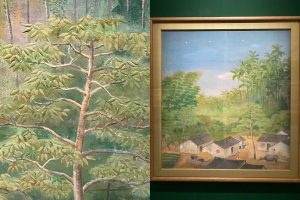
Lin Yu-shan's 'Recollections of the Old Garden', which was selected for the 9th Taiten's Eastern-style Painting Division, exhibits raised details. The piece is currently collected in the National Taiwan Museum of Fine Arts. Photo/© Li Meng-hsueh.
Nevertheless, the unique texture presented by gouache is unparalleled in Western-style painting. For example, the mineral pigments of gouaches will emit a faint golden light under the illumination of light, presenting a "low-key luxury" elegant texture. If you watch the gouache works of senior artists, you can see that they will use a raised method to process specific details, such as the leaves of trees, the stamens of flowers, and the jewelry worn by figures. This method is inherited from the "Lifen (trailed slip)" technique of ancient mural paintings. In addition to feeling the artist's meticulous processing of the painting, the viewer can also experience the accumulation and continuation of tradition.

Artist Tseng Chien-ying, who has been gaining popularity in recent years, studied ink painting at the academy and learned gouache on his own. His works are characterized by a strong style, presenting a contemporary look with traditional Eastern media. The photo shows Tseng Chien-ying's work at the 2015 ART TAIPEI "MIT Newcomers". Photo/ ©ART TAIPEI.
Today's creators are no longer bound by the limitations of media classification. They have learned a variety of techniques in school, and they have expanded the boundaries of gouache beyond specific styles or subjects. For example, Jan Chian-yu, who was taught by Lin Chih-chu at Tunghai University in the 1980s, created landscape paintings with gouache, reminiscent of the Tang Dynasty's blue-and-green landscape. Later, Wang I-jan focused on the human body as the main subject of her creations. Her portrayals are delicate and full of lust, and when they are rendered in gouache, they achieve an amplified effect. Tseng Chien-ying, born in the 1980s, fully demonstrated his contemporary vision across media, making full use of the characteristics of ink and paint to create a strong personality on the canvas, giving the audience a new visual impact. Whether gouache came from Japan or inherited the Chinese painting tradition, today's Taiwanese gouache has more facets and possibilities, waiting for the audience to explore in depth.
